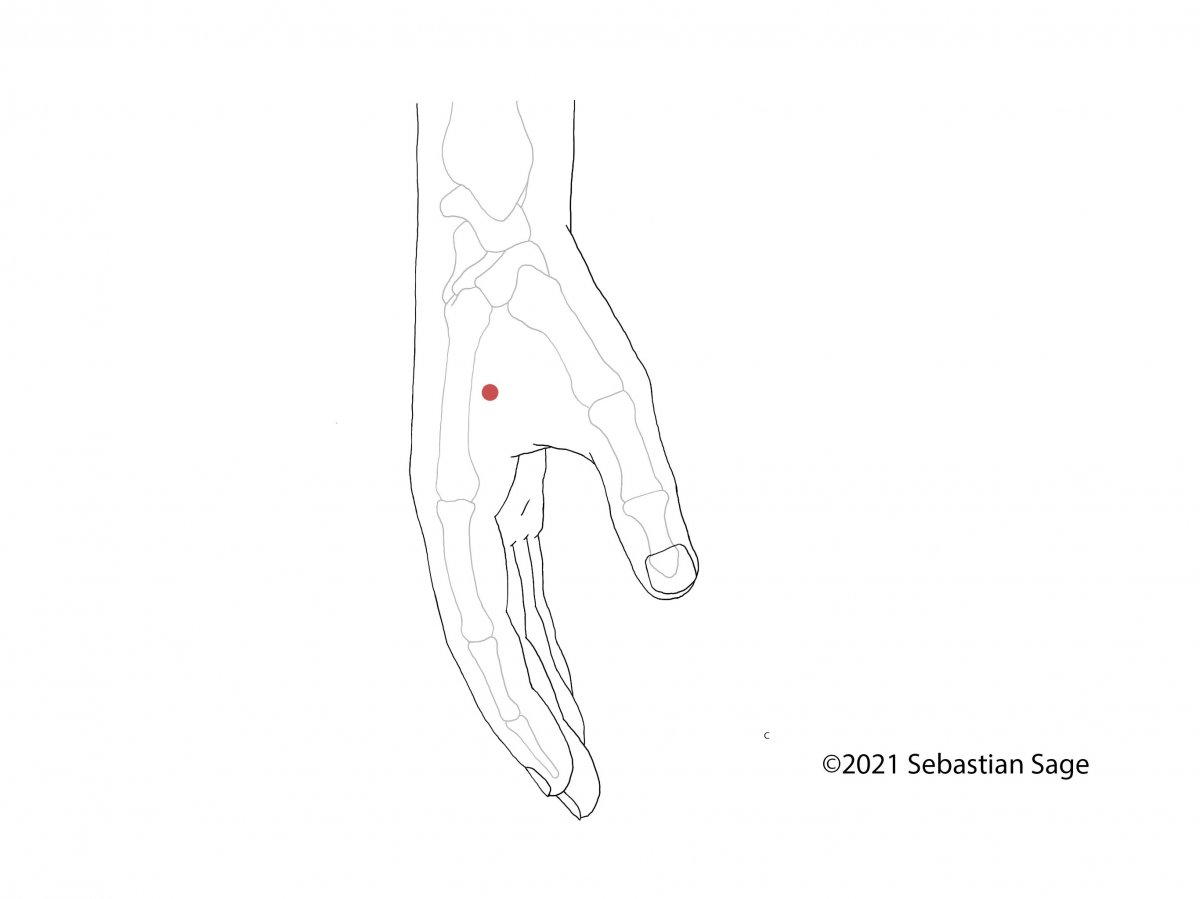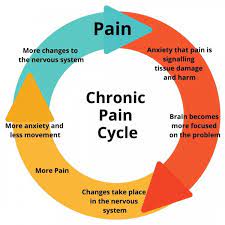Shiatsu is a Japanese style of massage therapy based on Eastern Medical Theory, that is the foundation for acupuncture. Shiatsu literally translates to 'finger pressure', and is often called 'acupuncture without the needles'. Shiatsu points are located on meridians, which are channels of energy that have been mapped on the body. These meridian channels have been used in Eastern healing practices for thousands of years. The essential idea is that we have energy (called Ki or Qi or Chi) flowing through these meridians. Sometimes this energy gets blocked, diverted or weakened resulting in aches, pains and other symptoms. Self-treating on specific points along these meridian channels can help to decrease pain and alleviate discomfort.
The first point I would like to introduce you to is Large Intestine 4. It is a particularly strong point that can help relieve frontal headaches, sinus pain, toothaches and pain along the arm. *This point should not be self-treated during pregnancy.*
Large Intestine 4 can be found in the webbing between the thumb and forefinger. You can find the point by pressing the index finger and thumb together, creating a mound. Large Intestine 4 is located at the high point of the mound. Once the point is located, release the thumb and apply pressure by pinching this area with your opposite thumb and forefinger. Angle the pressure toward the index finger. Hold the pressure for a breath and repeat as needed. Treat the point on both hands.
Chronic pain means that you have had the pain on and off for anywhere from three months to years. Like many, I have personally dealt with chronic pain on and off for years. When I encounterd my last pain episode two different doctors recommended surgery for my back. I've met people who have had wonderful results from back surgery, but I am too chicken shit. So I persevered, using a cane to get around, still giving treatments to my clients while trying to ignore my own issues. Now I understood what many of my exasperated clients told me when they said they wished they could sleep standing up. I was in so much pain that I could only sleep on my forearms and knees with pillows stacked up under my stomach, which really meant that I wasn't sleeping. My body would pass out for an hour or so from sheer exhaustion. This is certainly not a sleep position I would ever recommend. I rarely cry and shocked myself by bursting into tears at the drug store. My doctor had given me a pain prescription and I was eagerly dreaming of actually sleeping. The pharmacist burst that bubble telling me that the medication would take 2 - 3 weeks before I felt any difference. So there I was, ugly crying in the drug store. No help in sight as I stood there blubbering and watching people back away from me into the other aisles. Thoroughly embarrassed I finally stumbled outside wiping the tears and snot away when a thought came to me - 'You can do this Kim, you can get through this'. I became determined to find a way through the pain with self-treatment.
The best advice I received was very simple: move. When I was given this advice all I thought was, 'I can't. It hurts too much! How can I possibly do what they're suggesting? How much more pain can I endure?' Then the motivating words came - 'You will be in pain regardless if you move or not, so why not try?' I couldn't argue with that logic.
It honestly doesn't matter how small the movement is, as long as it doesn't increase your pain. At the beginning of my recovery the movements with my back could be measured in a few centimetres, but over time my mobility increased and better yet, my pain decreased!
There was a newletter recently from Harvard Medical School that talked about Tai Chi and Yoga as medication in motion rather than meditation in motion. It may take some time to get to the point where you can integrate a larger movement practice into your life. Remember to start small. Movement is lotion for the body and I truly believe it plays a big part in helping with chronic pain issues.
Somedays it is just so difficult to get anything done. We live in such a driven society that focuses on the need to achieve (even during pandemics) and I often feel guilty wanting more time for self-care. I know my body is often telling me that a nap would be perfect, but then that guilt bubbles up and I imbibe in caffeine instead. Sound familiar? It is so hard to balance activity with allowing for space and time to heal. To help with both the fatigue and the guilt, I want to recommend a book that I have fallen in love with called 'Radiant Rest - Yoga Nidra for Deep Relaxation & Awakened Clarity' by Tracee Stanley. Tracee is a teacher of yoga nidra and meditation, and as it says in the back of her book, ...she shares and teaches..."with the intention that everyone experiences their birthright of deep rest and awakening to their innate power and wisdom." You can check her out on YouTube. I guarantee that just the sound of her voice will immediately make you feel more grounded. Her meditations have helped me feel rested, lighter and able to look forward to the day again.
You are partway through your day and you can feel the headache coming on. You know that if you could just stop what you're doing, throw yourself under some blankets and forget the world, you might stand a chance of feeling okay. But you can't, and all you can think of is...uh oh, here it comes.
There are many little tips that can help.
- Take a tiny break. It's worth it to regroup and just sit with yourself.
- Water! We often forget to drink water, and dehydration can lead to headaches. Studies show that even mild dehydration can affect concentration. A few sips of water can help stimulate you and keep you alert.
- Move! Just looking around (away from your computer) can help ease some tension in your neck and shoulders - the same tension that can lead to headaches. Take a look at your ceiling, take a look at your floor, look towards each shoulder and then tilt your ear towards each shoulder. Each easy movement will help decrease some of that tension.
- Gently self-massage across your forehead and into your temples. While sitting put your elbows on your desk or the table in front of you. Put the fingertips of both hands along the centre line of your forehead. Allow the weight of your head to rest on your fingertips. Slowly separate your hands, allowing your fingers to easily massage your forehead across from that centre line outwards. From here you can massage the temples on each side with gentle circles.
Often we know what to do when we are experiencing discomfort. This blog is a reminder to take some time for yourself and please, don't be afraid to touch yourself.
As a massage therapist I am very aware of the incredible amount of tension many people carry. Often both my clients and myself wish it were feasible for them to recieve treatments every few days. What has surprised me in my practice is the feedback I have recieved when I suggest that clients massage themselves to help decrease pain and discomfort in between treatments. Comments have ranged from "I don't know how" and; "Won't I do some damage to myself?" to; "I didn't think I could do that to myself"; and "What if I hurt myself?"
I started to realize that these thoughts are very common, and that they say a lot about the disrupted state of our mind-body connection. Obviously if my clients who were comfortable recieving massage therapy treatments were having these troubling and uneasy thoughts, just think of the people who are uncomfortable with having someone else touch them. Would they be agreeable with self-help measures such as self-massage?
Well I am here to tell you: Please do not be afraid to touch yourself! Self-massage is a safe and effective treatment for all ages, from childhood to senior years, and it will help you achieve better health and improve the quality of your life.

